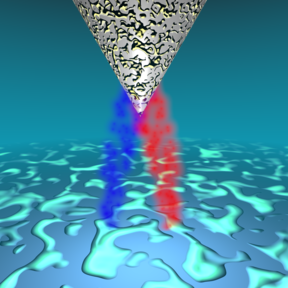An atomic-scale window into superconductivity paves the way for new quantum materials

Superconductors are materials with no electrical resistance whatsoever, commonly requiring extremely low temperatures. They are used in a wide range of domains, from medical applications to a central role in quantum computers. Superconductivity is caused by specially linked pairs of electrons known as Cooper pairs. So far, the occurrence of Cooper pairs has been measured indirectly macroscopically in bulk, but a new technique developed by researchers at Aalto University and Oak Ridge National Laboratories in the US can detect their occurrence with atomic precision.
The experiments were carried out by Wonhee Ko and Petro Maksymovych at Oak Ridge National Laboratory, with the theoretical support of Professor Jose Lado of Aalto University. Electrons can “quantum tunnel” across energy barriers, jumping from one system to another through space in a way that cannot be explained with classical physics. For example, if an electron pairs with another electron right at the point where a metal and superconductor meet, it could form a Cooper pair that enters the superconductor while also “kicking back” another kind of particle into the metal in a process known as Andreev reflection. The researchers looked for these Andreev reflections to detect Cooper pairs.
To do this, they measured the electrical current between an atomically sharp metallic tip and a superconductor, as well as how the current depended on the separation between the tip and the superconductor. This enabled them to detect the amount of Andreev reflection going back to the superconductor, while maintaining an imaging resolution comparable to individual atoms. The results of the experiment corresponded exactly to Lado’s theoretical model.
This experimental detection of Cooper pairs at the atomic scale provides an entirely new method for understanding quantum materials. For the first time, researchers can uniquely determine how the wavefunctions of Cooper pairs are reconstructed at the atomic scale and how they interact with atomic-scale impurities and other obstacles.
'This technique establishes a critical new methodology for understanding the internal quantum structure of exotic types of superconductors known as unconventional superconductors, potentially allowing us to tackle a variety of open problems in quantum materials,' Lado says. Unconventional superconductors are a potential fundamental building block for quantum computers and could provide a platform to realise superconductivity at room temperature. Cooper pairs have unique internal structures in unconventional superconductors which so far have been challenging to understand.
This discovery allows for the direct probing of the state of Cooper pairs in unconventional superconductors, establishing a critical new technique for a whole family of quantum materials. It represents a major step forward in our understanding of quantum materials and helps push forward the work of developing quantum technologies.
Original publication:
Noncontact Andreev Reflection as a Direct Probe of Superconductivity on the Atomic Scale
https://pubs.acs.org/doi/full/10.1021/acs.nanolett.2c00697
Contact information:
Jose Lado
Assistant professor
+358503133730
jose.lado@aalto.fi
Read more news

Research Council of Finland establishes a Center of Excellence in Quantum Materials
The Centre, called QMAT, creates new materials to power the quantum technology of coming decades.
Two Unite! Seed Fund projects involving Aalto secure top EU funding
Two prestigious EU grants have been awarded to projects that were initially supported with Unite! Seed Funding. Both projects involve Aalto.
Major funding powers development of next-generation machine technology aimed at productivity leap in export sectors
The BEST research project is developing new types of sealing, bearing, and damping technology.






